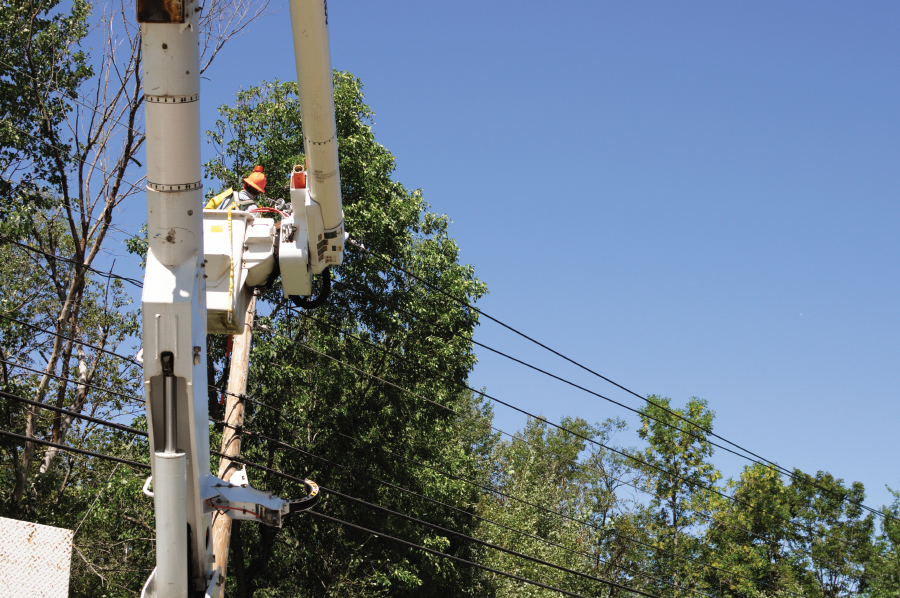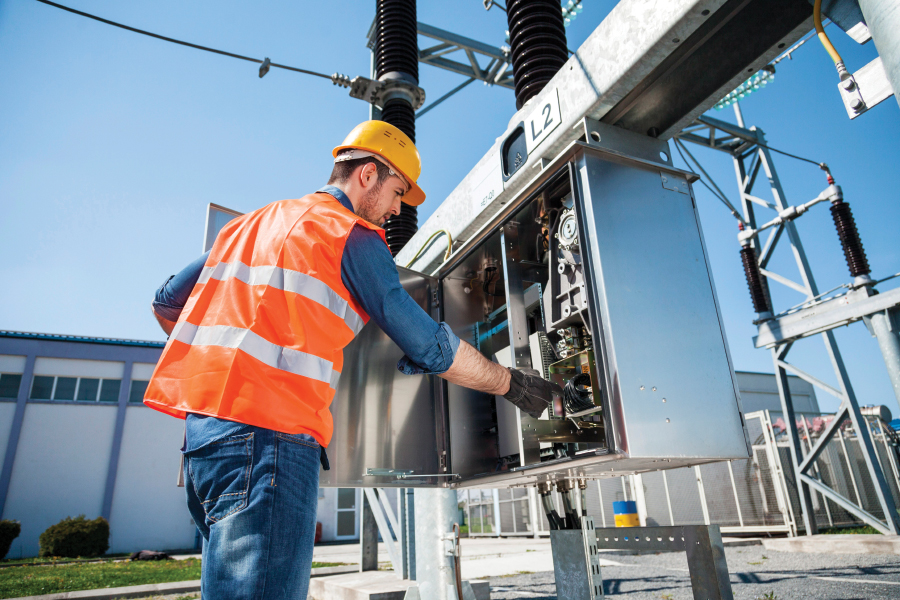
Source: Image taken from the white paper called The Potential of the Internet of Things for Utilities published by Panasonic Connect.
The utility industry is grappling with significant challenges — from workforce shortages to aging infrastructure to cybersecurity threats — that need to be overcome to ensure long-term sustainability and meet the growing demands of customers.
Right now, about 56% of energy workers have 10 or fewer years of service experience, so the industry is focusing on training and upskilling a newer, less-experienced workforce. Aging infrastructure is a further challenge for utilities everywhere, as older systems must be maintained to prevent failures, and companies must invest in their grid infrastructure to enhance resilience and reliability given increases in demand and extreme weather events. Additionally, companies must enhance cybersecurity and awareness of vulnerabilities in the power grids, with the number of susceptible points in electrical networks increasing by about 60 per day, according to the North American Electric Reliability Corporation (NERC).
These challenges, and many others, underscore the urgent need for an integrated approach to digitalization, in which hardware, software and services are deployed in a strategic, holistic manner to position utility companies for both immediate success and future growth.
Durable, connected and reliable hardware
When it comes to selecting the right kind of hardware for utility workers, there are many features to consider. The devices must be able to withstand the environments that utility workers are subject to daily, including extreme weather conditions and high-pressure situations that demand instant response. The devices must also be equipped with reliable connectivity so utility workers can stay connected no matter where their job takes them, including in rural and secluded areas. Additionally, utility workers need devices capable of handling all their needs, so they don’t have to carry multiple devices or adaptors. Long battery life is also essential, as the last thing workers should be worrying about when servicing areas that have been impacted by a disaster or outage is finding an outlet to charge their device.
Rugged mobile solutions are an ideal solution for many utility workers. Built with remote workers in mind — in fields ranging from the public sector to field service to the military — rugged computing devices help utility workers optimize operations, streamline workflows and increase productivity. The devices are built to withstand harsh conditions, including freezing temperatures, extreme heat, drops, spills, dust and dirt. This durability ensures that workers don’t have to worry about their devices breaking or causing delays. For example, a lineworker working to restore powerlines after a winter storm can use their rugged device to pinpoint where outages are occurring without concern for the device failing in low temperatures, allowing them to focus on quickly and effectively restoring power to the community.
The latest rugged mobile devices offer multiple connectivity options, including 4G, 5G and other industry-specific Private LTE networks, so field personnel are always able to communicate effectively, access real-time data and location information and receive critical updates regardless of their location. This enhances their ability to respond swiftly to issues and maintain continuous operations, no matter where they are. For example, a utility worker might need reliable connectivity when detecting and repairing an underground water pipe leak in a rural area, so they can accurately identify the location and severity of the leak using real-time Geographic Information System (GIS) or other data. Reliable connectivity allows them to swiftly identify the leak, minimize excavation and execute precise repairs, ultimately reducing service disruptions and preventing further infrastructure damage.
Modular rugged devices can meet workers’ many needs with a single device, with accessories like barcode scanners, extra batteries and additional ports added as needed. That flexibility is critical for utility workers, who often need to connect to legacy hardware using cabled serial ports, external metering devices and specialized diagnostic equipment to interface effectively with and maintain older systems. Workers also may need hot-swappable batteries to support their long shifts in the field, as they may not have the luxury of charging their devices in an office setting.
A technician troubleshooting issues with a transformer might need to connect to diagnostic tools and equipment through serial ports, while also using a barcode scanner to track parts and relying on an integrated GNSS system for navigation and precise location positioning for the asset. A single rugged device can support all these needs and more, so workers can reduce downtime, increase productivity and ensure efficient, uninterrupted service in challenging environments.
Software integration for enhanced utility operations
Utility companies must ensure that the hardware they choose to use is compatible with their preferred software applications. Integrated software improves data collection, diagnostics, security and overall operational efficiencies, and when fully compatible with the hardware, it gives workers an intuitive user experience and allows them to interact with legacy systems. Hardware and software companies need to work together to ensure that their devices provide reliable performance, support essential applications and integrate easily into daily operations.
In the example shared earlier in which a utility worker is tasked with locating and repairing underground water pipe leaks in a rural area, leak detection software integrated with GIS data on a rugged device with multiple connectivity options provides a compelling solution. The hardware and software can be used to accurately identify the leak’s location while reducing the amount of digging required and minimizing disruption. By pinpointing the precise spot of the leak using user-friendly software, the utility worker can expedite repairs, restore service faster and avoid unnecessary excavation.
Cybersecurity is another challenge that can be addressed with integrated hardware and software solutions. Utility companies must monitor, identify and respond immediately to security threats on the power grid using cybersecurity software that’s integrated with real-time threat detection and response systems. The latest software can analyze network traffic, detect anomalies and alert utility companies to suspicious activities, so companies can take swift action to secure critical infrastructure. Using these advanced security tools, workers can prevent breaches, ensure the integrity of the grid and continue to deliver uninterrupted service to customers.
Comprehensive service and support
The job does not end after selecting the right device and ensuring that it is compatible with the necessary software — from unboxing to registration and imaging to configuring multiple settings, the steps following purchase can be the most time-consuming. That’s why, in addition to hardware and software, utility companies must seek out technology partners that offer services and support throughout the deployment process and device lifecycle.
As the last piece of the puzzle, services and support provide the extra help that many short-staffed utility companies (including small or mid-sized utilities that may be limited in IT staff) need to ensure their hardware and software are correctly set up, deployed and maintained. Professional services and support can maximize uptime and accelerate return on investment, as well as enhance operational efficiency, reduce costs and help utility companies deliver reliable service to their customers.
Services and support can also alleviate some of the pressure that falls on IT teams. For instance, technology partners can provide proactive device monitoring and remote diagnostics for early detection of cyber threats, minimizing potential disruptions and optimizing device performance. Additional services may include support for routine tasks, such as device monitoring and repairs, so full-time teams can focus more on strategic business initiatives.
By partnering with a technology company that provides anytime and as-needed IT staffing solutions, companies gain an extension to their IT staff through their technology partner, relieving in-house specialists.

Source: Image taken from the white paper called The Potential of the Internet of Things for Utilities published by Panasonic Connect.
An ecosystem for success
With the right synergy of hardware, software and services, utility companies can achieve operational excellence, enhance reliability and ensure resilience in a dynamic environment. By deploying robust hardware solutions designed to withstand harsh conditions, integrating sophisticated software and taking advantage of comprehensive service and support, utility companies can streamline workflows and bolster efficiency, ultimately helping them overcome the challenges facing the industry today.
Looking ahead, the prevalence of AI and AI-enabled computing will continue to transform utility operations and help achieve future success in the industry. With 74% of energy and utility companies implementing or exploring using AI in their operations, utility companies need to take full advantage and equip their workforce with AI-enabled devices that are designed to accelerate data-driven tasks like optimizing grid management, improving predictive maintenance and finding operational efficiencies. While out in the field, utility workers can leverage these tools to analyze large datasets from meters to predict failures before they occur, with incredible speed. But, to do so, the device must be both rugged to work in harsh environments and powerful to process large amounts of information in near real-time. To fully harness AI’s transformative potential, utility companies need to invest in an integrated ecosystem of AI-compatible hardware, advanced software and comprehensive services designed for enhanced collaboration and operational excellence.
While hardware, software and services are all important on their own, it is the combination of all three that enables utility companies to deliver exceptional service to their customers. This holistic approach — aided by an experienced and future-looking technology partner — positions utility companies to meet evolving customer demands with agility and confidence and optimize operations for long-term success.
 Chad T. Hall serves as executive business development manager at Panasonic Connect, overseeing the development of rugged mobile solutions to support the utility sector. He obtained his bachelor’s degree in geography and master’s degree in geographic information science and cartography from Texas State University.
Chad T. Hall serves as executive business development manager at Panasonic Connect, overseeing the development of rugged mobile solutions to support the utility sector. He obtained his bachelor’s degree in geography and master’s degree in geographic information science and cartography from Texas State University.








